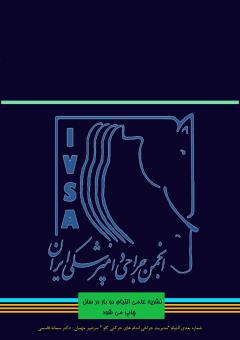Maternal Dystocia: Causes and treatment
Subject Areas : Clinical Complications and their Treatments
Niloufar Tashakkori
1
*
![]() ,
nima farzaneh
2
,
nima farzaneh
2
![]()
1 - Student, Department of Clinical Sciences, Faculty of Veterinary Medicine, Ferdowsi University of Mashhad
2 - Professor, Department of Clinical Sciences, Faculty of Veterinary Medicine, Ferdowsi University of Mashhad, Mashhad, I.
Keywords: Cattle, dystocia, maternal dystocia,
Abstract :
Maternal dystocia includes defects of the birth canal and defects of the expulsive forces. Defects of the birth canal would be due to the pelvic constriction, failure of cervical dilation, incomplete relaxation of the caudal vagina and vulva and other physical abnormalities causing obstruction such as remnants of the paramesonephric ducts. The expulsive force of labour is due to a combination of myometrial contractions and straining induced by the contraction of the abdominal muscles with a closed glottis. Because the abdominal muscles do not come into play until the myometrium has forced the fetus and fetal membranes into the pelvic canal and stimulated the pelvic sensory nerve receptors, it is logical to consider first the expulsive deficiencies that may arise in the myometrium. These may occur spontaneously or dependently and are called, respectively, primary and secondary uterine inertia.
1. Noakes DE, Parkinson TJ, England GC. Arthur's Veterinary Reproduction and Obstetrics-E-Book: Elsevier Health Sciences; 2018.
2. Mee JF. Prevalence and risk factors for dystocia in dairy cattle: A review. The Veterinary Journal. 2008;176(1):93-101.
3. Mee JF. Managing the dairy cow at calving time. Vet Clin North Am Food Anim Pract. 2004;20(3):521-46.
4. Sloss V, Duffy JH, editors. Handbook of bovine obstetrics1980.
5. Lyons N, Knight-Jones T, Aldridge B, Gordon P. Incidence, management and outcomes of uterine torsion in UK dairy cows. Cattle Pract. 2013;21:1-6.
6. Frazer G, Perkins N, Constable P. Bovine uterine torsion: 164 hospital referral cases. Theriogenology. 1996;46(5):739-58.
7. Purohit GN, Barolia Y, Shekhar C, Kumar P. Maternal dystocia in cows and buffaloes: a review. Open journal of Animal sciences. 2011;1(02):41.
8. Aubry P, Warnick LD, DesCôteaux L, Bouchard É. A study of 55 field cases of uterine torsion in dairy cattle. The Canadian veterinary journal. 2008;49(4):366.
9. Schönfelder A, Sobiraj A. ätiologische Aspekte der Torsio uteri beim Rind: Eine übersicht. Schweizer Archiv für Tierheilkunde. 2005;147(9):397-402.
10. Ghosh SK, Singh M, Prasad J, Kumar A, Rajoriya A. Uterine torsion in bovines-a review. Intas Polivet. 2013;14(1):16-20.
11. Manning J, Marsh P, Marshall F, McCorkell R, Muzyka B, Nagel D. Bovine uterine torsion. The Bovine Practitioner. 1982:94-8.
12. Prabhakar S, Singh P, Nanda A, Sharma R. Clinico-obstetrical observations on uterine torsion in bovines. Indian Veterinary Journal. 1994;71(8):822-4.
13. Roberts S, editor Diagnosis and Treatment of Cows with Cystic Ovaries. American Association of Bovine Practitioners Proceedings of the Annual Conference; 1972.
14. Menard L. The use of clenbuterol in large animal obstetrics: manual correction of bovine dystocias. The Canadian Veterinary Journal. 1994;35(5):289.
15. Schaffer W. Schweizer Arch. Tierheilk. 1946;88:44.
16. Nanda A, Sharma R, Nowshahari M. The clinical outcome of different regimes of treatment of uterine torsion in buffaloes. Indian J Anim Reprod. 1991;12(2):197-200.

